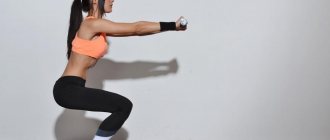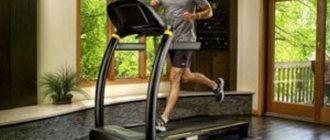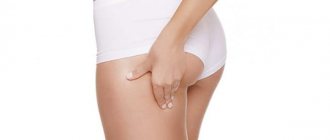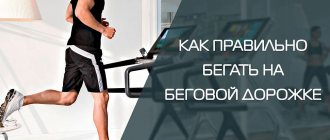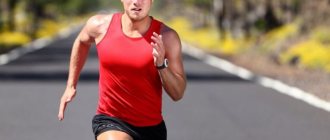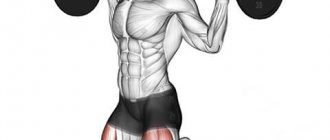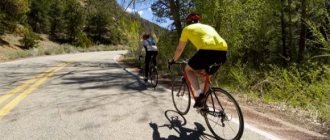Is it possible to get bigger buttocks just by running?
Experts who study the question of whether it is possible to pump up the buttocks by running believe that running can:
- increase endurance;
- strengthen the gluteal muscles;
- improve overall body tone.
Therefore, when asked whether it is possible to pump up your butt on a treadmill, a number of trainers will give a positive answer. According to other athletes, running produces less effect compared to abdominal exercises, weighted squats, bending and fitness. To increase the benefits of this type of physical activity, it is important to do the following exercises:
- With acceleration.
- With a rise to heights.
- On the steps.
- With a change of speed.
Running training should be combined with race walking. To strengthen muscles, a high rise of the legs when running is important and, if desired, training can be combined with walking on a stepper.
To minimize the pain effect, it is important to warm up before the main activity.
Running exercises
Regular running will not allow you to achieve pronounced results in the buttocks area. To do this you need to use special techniques. To tighten your gluteal muscles while running, your workout should include the following exercises:
- Acceleration running – involves increasing speed to maximum. Its increase is ensured by lengthening steps and increasing cadence. When you reach high speed, you need to run at this pace for approximately 25% of the distance. Such intense runs will help burn calories and, accordingly, reduce fat in the buttocks.
- Jogging. A special feature is the speed, which should reach 9 km per hour. When running, your feet should be slightly relaxed to “shuffle” on the surface. At the same time, the “flight phase” is shortened. When you push off with one leg, the other should almost land. The body should be kept slightly tilted in the direction of movement. Jogging promotes fat burning specifically in the lower extremities and buttocks area.
- Running uphill - the need to maintain balance forces the back and abs to work, since the body should not collapse too much. The foot should be placed first on the front part, and then only on the heel. At the same time, the frequency of steps increases and the hip moves forward, and due to the application of effort during this pushing movement, the gluteal muscles are activated and the intensity of fat burning increases.
- Running up and down the steps is an exercise that everyone can do. It's good if the training takes place outdoors. You need to run at an average pace. You can climb 2-3 flights of stairs and then go down. You can do several approaches. But not everyone can do such a cardio load. In an hour of such training, 1000 calories are burned. In this case, you need to run for at least 30 minutes.
- Running with changes in speed. With this type of running, high speed alternates with low speed. Such jogging helps burn calories and grow muscles.
Jogging before the main workout
Running sessions are often used as a warm-up before weight training. It helps:
- reduce body weight by reducing the layer of subcutaneous fat;
- increase the body's endurance.
When using running as a warm-up, you should avoid intense exercise. In the initial stages, it is enough to limit yourself to a short jog. It is important to remember that the exercise is performed to warm up the muscles. And it is better to set more difficult tasks not when running, but on subsequent strength approaches. At the same time, you need to know what you can eat before a run and what to eat after it.
Special exercises on the treadmill
To increase the effectiveness of your training, you can use the following complex:
- Squats. To do this, you need to sit sideways on the treadmill, adjusting the speed to the optimal pace. The exercise consists of rearranging your legs with squats. In terms of effectiveness with the same hack simulator, of course, this exercise is not up to par, but it will still benefit the gluteal muscles.
- Lunges are another method of how to pump up your butt on the treadmill. They can be done in several ways. A simple option involves performing a lunge on each step.
- Lunges with emphasis require placing one leg on the runners with the other lowering onto the moving part of the machine. As you move, you should ensure that your hands rest on the handles and your knees are bent. After returning the back leg to the starting position, the action is repeated.
- Diagonal lunges are different in that the foot is placed on the opposite side of the stationary bottom of the track.
- You can increase the load by combining a lunge with a leg raise. To do this, you need to raise your leg parallel to the ground during the final phase of the lunge.
- Effective exercises for the buttocks are walking sideways and backwards. The task can be complicated by lifting movements.
- To perform the “chair” you need to position yourself with your back to the front of the track and with emphasis on your hands, then bend your legs almost 90 degrees, as when sitting on a chair. From this position you need to move your legs. The half-chair is performed in a similar way, only the angle of bend of the legs changes.
Therefore, walking and running are not the only ways to pump up your butt on the treadmill. By gradually complicating the program through additional tasks, you can strengthen and maintain the positive effect of the classes.
Video. How to pump up your buttocks without squats
Legs and buttocks: the best exercises at home
How to avoid injuries when running. Stretching tight buttocks.
How to pump up your butt. Butt workout
- >
Legs and buttocks: the best exercises at home
Strength training to strengthen your entire body, avoid injury, and add energy to your run
- >
How to avoid injuries when running. Stretching tight buttocks.
Today I will introduce you to an incredibly effective stretching! What a miracle it is to stretch the muscles of your buttocks. If you often sit or have done a good workout of your buttocks, this stretch is definitely for you!!!
- >
What muscles work when running?
To determine whether your butt sways when running, it is important to understand which muscle groups work:
- to maintain the body in an upright position, the work of the gluteal muscles is necessary;
- the thigh and iliacus muscles are responsible for bending the knee joint, pain in which indicates the need to stop training;
- when extending the legs, the quadriceps are involved;
- The calves are responsible for lifting the foot and stabilizing the body.
Consequently, while running, the hip system of the body is strengthened. In this way, it is possible to increase the tone of other muscle groups.
Training scheme
Having considered whether running improves your butt, it is worth considering an approximate set of exercises that will allow you to achieve your goal. It includes:
- warm-up in the form of easy walking for 5-10 minutes;
- alternating squats and lunges with walking, you need to change the type of activity every minute;
- lunges with emphasis and diagonal, half a minute on each side;
- walking;
- lunges with leg raises, 1 minute;
- running 7-9 km/h;
- walking sideways, including with abduction of the leg;
- running with your back;
- high chair;
- half-chair;
- hitch.
It is believed that in the initial stages it is important to perform the program every 2 days. Then the frequency of training can be increased.
Pulling the leg with a load back
Yes, this exercise is completely aimed at training the gluteal muscle . It has only one drawback: you cannot do it with heavy weight. And with low weight you will get almost no results. It is best suited for warming up the buttocks.
But if you are persistent enough and are ready to do this exercise for at least half a year, then your buttocks will certainly tighten up and take on a good shape.
Another disadvantage of this exercise is that it takes twice as long as regular exercises. Because it needs to be done with each leg in turn.
In this exercise, the supporting leg should be slightly bent at the knee.
The bench leg press is a good basic exercise for the hips, but it doesn't work the glutes much.
The platform is raised using the strength of the hips. This occurs because the torso is perpendicular to the weight being lifted. (See pictures)
In order for the buttocks to be involved in the work, the weight must be lifted along the line of the torso.
Three exercises can be successfully used for these purposes:
• Smith machine
• Hook machine
• Squats with a barbell (not a lot of weight for girls) on the shoulders.
When and how much to run?
The reason why trainers do not give a definite answer to the question of whether running helps to pump up your butt is the quality of the classes. Some people believe that regular jogging will help achieve their goal. In fact, you should not expect a significant effect if you ignore the basic principles of training.
The first of them is a gradual progression of the load. This means that in the next workout you need to run at least 2 minutes longer than the previous one. Or include new exercises in the load.
The second involves training in the supercompensation phase, which involves restoring the body with the reserve necessary to overcome a similar load with less effort. The onset of the phase is determined by the loss of painful sensations, the emergence of a desire to train and the ability to cope with a greater volume of load than before. Therefore, physical and emotional sensations allow you to check whether your buttocks swing when running.
The third principle is to gradually increase the load. Practice has shown that a realistic view of plans and perseverance in their implementation give greater results than high-intensity training with subsequent failures. Therefore, if you want to run to pump up your legs, it is important to take into account all aspects when choosing a program, as well as stick to the intended course, making adjustments as necessary.
Varieties of running for the buttock muscles
A program that allows you to pump up your leg muscles may include:
- Sprint. This is what they call fast races over limited distances. To avoid harm to health, it is important to gradually increase the load.
- Short runs at a vigorous or moderate pace. It is important to combine such a load with walking, which provides relaxation and rest.
- Exercises on a treadmill for the buttocks.
The latter option is preferable for people who prefer to exercise indoors, as well as control the load and can remove hollows on the sides of the buttocks.
How to run correctly to pump up your legs
To pump up your legs while running, you need to :
- Start running from short distances on level ground, since if you immediately load your legs by running up any hill or do it for a long time without rest, you can get a serious injury.
- Find the technique that will be convenient for your physical fitness.
- Depending on the chosen technique, follow the rules of foot placement when running. Let's say that when running a long distance you need to put your foot on your full foot or roll from heel to toe, and in short races at speed you need to run on your toes.
- It is also important to choose the right, comfortable shoes that will not cause discomfort while jogging.
- Before each race you need to do a warm-up , and after it - stretching . This will help not injure your legs, as well as get rid of discomfort the next day after training. Starting to run without warming up puts a lot of stress on your heart.
Benefits of running for the buttocks
Running is useful for those who want to lose weight or build muscle mass. The result depends on the load and the proportion of strength exercises in the training program. In the question of whether running helps build muscles, it is important to consider that such a load will speed up metabolism, activate fat burning and give stress to different parts of the body. These are the keys to getting rid of subcutaneous fat deposits and building muscle. Consolidation of the result also depends on a healthy lifestyle and proper nutrition.
In addition to the fact that running can pump up your butt, such exercises are useful in other areas. He helps:
- strengthen the heart muscle;
- improve blood circulation;
- strengthen the immune system;
- ensure the prevention of joint diseases;
- fight shortness of breath, blood pressure problems and runny nose;
- harden the body;
- cope with depression, which is often the cause of unhealthy eating and living habits;
- get and maintain beautiful, pumped up legs.
Having considered the topic of whether it is possible to pump up your buttocks and butt by running, let’s summarize: there is no way to easily correct figure flaws. Beautifully shaped butts and buttocks depend on meeting several conditions. Firstly, it is important to swing correctly and constantly monitor the load level. Secondly, exercise and running need to be allocated time in your schedule, avoiding disruptions. Consequently, it depends on the efforts and determination of a person whether it is possible to pump up muscles and maintain the achieved result.
Recommended entries:
Therapeutic physical training for the back and exercises for the cervical spine
A sedentary lifestyle and hanging out on gadgets have a negative impact on the condition of our spine, including the cervical...
Gluteal bridge: technique for performing the exercise at home and in the gym with a barbell on a bench or any other weight
Every woman dreams of an ideal figure. A woman who visits a fitness club knows that a beautiful butt is one of...
Dynamic plank: how to pump up almost your entire body by devoting just 5 minutes a day to one exercise
The exercise works quite effectively on most muscle groups; if you do it regularly, then in a short period of time you can...
Running efficiency
Running does a great job of increasing endurance and also stimulates the activity of burning fat tissue. If we talk about muscle strengthening, then running for the buttocks takes on some specificity, since it differs from regular jogging. There is an opinion that it is almost impossible to pump up your butt while running. This is partly true: running tightens the buttocks well, and is also able to strengthen them, subject to specific training rules, but it is not capable of pumping up this part of the body
For this reason, in order to obtain maximum results, you should perform additional exercises:
- Squats using weights.
- Pulling back the leg bent at the knee joint. Starting position: kneeling. If the technique of this exercise is performed correctly, a characteristic burning sensation , which indicates the effectiveness of the exercise.
- Starting position: kneeling. The leg in a straight position is moved to the sides and back. If you want to increase the load, you can weight the lower limb with a load.
- Incline exercises with crossed legs. The starting position should be straight. The legs are crossed and the pelvis is pulled back. Shallow inclined movements are made at a uniform pace. When performed correctly, a feeling of stretching appears in the area of the buttocks and posterior femoral surface. The ideal time to conduct such training is the end of the training process. Thus, stretching and relaxation of muscle tissue occurs simultaneously.
- Raising the pelvis in a lying position. Raising the pelvis should be done without interruption from the floor of the shoulder blades and back. In this case, the hands should be placed behind the head or along the body. Legs can be bent at the knees or in a crossed position.
This is interesting
- [uaf_vkcount url='href=»https://beginogi.ru/vitaminyi-dlya-myishts-sustavov-i-svyazok-i-kakie-vitaminyi-nuzhnyi-dlya-rosta-myishts/']
Vitamins for muscles, joints and ligaments and what vitamins are needed for muscle growth
